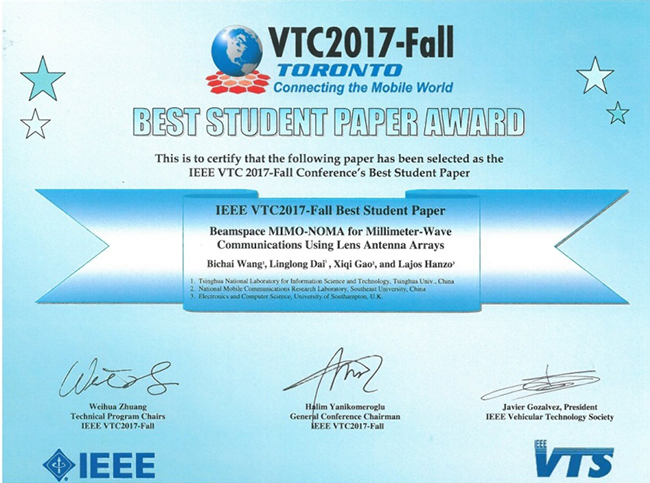PhD Candidate from the Department of Electronic Engineering Wins IEEE VTC 2017-Fall Best Student Paper Award
From Sep 24th to 27th, the 2017 IEEE 86th Vehicular Technology Conference (IEEE VTC 2017-Fall) was held in Toronto, Canada, hosted by the Institute of Electrical and Electronics Engineers (IEEE). The paper, entitled Beamspace MIMO-NOMA for Millimeter-Wave Communications Using Lens Antenna Arrays, with Bichai Wang, PhD candidate from the Department of Electronic Engineering of Tsinghua University as its first author, won the only IEEE VTC 2017-Fall Best Student Paper Award.
The IEEE Vehicular Technology Conference is an important academic conference in the domain of wireless communication technologies. The research areas of this conference include wireless communication, cognitive radio, cooperative communications, positioning technology, vehicular communications, and similar related fields. The conference is organized twice each year, in Spring and Fall, and has a history of 43 years until the present. The conference this year (the 86th session) has a new record number of submissions, and 475 papers were accepted. At the end, one paper received the Best Paper Award, and one paper received the Best Student Paper Award. The percentage of winning papers was 0.4%.

In future 5G millimeter-wave (mmWave) communications, beamspace MIMO technology can significantly reduce the number of required radio-frequency (RF) chains in mmWave massive MIMO systems, thereby significantly reducing system power consumption. However, a fundamental limit of beamspace MIMO is that the maximum number of users that can be supported cannot exceed the number of RF chains, which limits the further improvement of system capacity. This paper aims to break this fundamental limit by proposing a spectrum and energy efficient mmWave transmission scheme that integrates the new concept of non-orthogonal multiple access (NOMA) with beamspace MIMO, i.e., beamspace MIMO-NOMA. In the proposed beamspace MIMO-NOMA scheme, the number of users can exceed the number of RF chains, and the system capacity can be also significantly improved. Furthermore, this paper proposes a corresponding precoding design and power optimization algorithm to maximize the achievable sum rate. The proposed scheme can also be directly applied to the hybrid precoding structure, which provides important ideas and solutions for the practical application of mmWave massive MIMO technology.
Bichai Wang obtained a bachelor’s degree from the Department of Electronic Engineering of Tsinghua University in 2015, and was granted direct entry without examination to the postgraduate program of the same department in September of the same year. In the past two years, Bichai Wang has focused on research into non-orthogonal multiple access (NOMA), and has published four journal papers in IEEE Journal on Selected Areas in Communications, IEEE Communications Magazine, and IEEE Communications Letters. In 2016, Bichai Wang was awarded the National Scholarship for Graduate Students.
Associate Professor Linglong Dai of the Department of Electronic Engineering is her supervisor as well as the second author of the winning paper. His team has engaged in continuous and in-depth research into wireless communication technologies for 5G, and has achieved fruitful results. The co-authors of the winning paper also include Professor Gao Xiqi from Southeast University, China, and Professor Lajos Hanzo from the University of Southampton, UK.
(By Zhu Lvhe)

